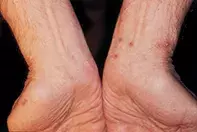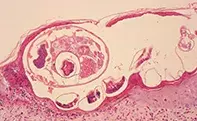What’s the diagnosis?
Generalised itching with wrist lesions


Papular urticaria presents as urticated papules that are erythematous and often excoriated. These usually follow insect bites. Skin biopsy shows separation of keratinocytes (spongiosis) with superficial and deep lymphocytic inflammation and eosinophils. Rarely, insect bite parts may be retained in the skin.
Papular eczema may complicate patches of dermatitis and is characterised by excoriated papules. Biopsy shows epidermal spongiosis and superficial lymphocytic inflammation and eosinophils.
Larva migrans is usually associated with serpiginous burrows that typically occur on the acral areas or back. Skin biopsy shows superficial lymphocytic inflammation and eosinophils. The worms are rarely seen on the skin biopsy.
Scabies is the correct diagnosis here. It is due to a mite that may be present in isolated burrows or may number hundreds (Norwegian or crusted scabies). The latter state is seen particularly in immunosuppressed patients. Major clues to diagnosis are the intense itching, which characteristically spares the face and head, and the presence of genital lesions. Skin scraping of a burrow or examination by dermatoscopy often reveals the mites, their eggs and faeces, allowing for definite diagnosis. Skin biopsy demonstrated cuticular lined structures under the stratum corneum and superficial dermal eosinophilia (Figure 2). A history of itching in other affected family members may be obtained. Treatment Scabies is usually treated with topical scabicides, including 5% permethrin cream or lotion or 25% benzyl benzoate, which should be applied to all the skin. The face and head may not need treatment except in immunosuppressed patients or young children or in Norwegian scabies. Resistance to scabicides may be seen. Oral ivermectin, with a single dose of 200 µg/kg, may be useful in patients for whom topical treatment has failed or in immunosuppressed individuals. Simultaneous treatment of contacts is also important to minimise recurrence.
A 35-year-old man gave a six-week history of intense generalised pruritus that was worse at night. The itching spared the face and head. Examination revealed multiple excoriated urticarial papules over the trunk and some linear crusted lesions on both wrists (Figure 1) and in the interdigital clefts.

